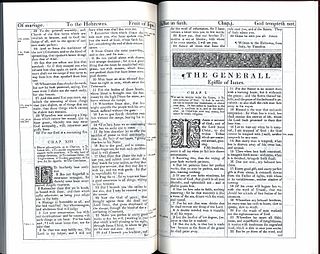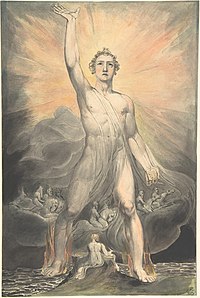
John 17 is the seventeenth chapter of the Gospel of John in the New Testament of the Christian Bible. It portrays a prayer of Jesus Christ addressed to his Father, placed in context immediately before his betrayal and crucifixion, the events which the gospel often refers to as his glorification. Lutheran writer David Chytraeus entitled Jesus' words "the prayer of the high priest". Methodist theologian Joseph Benson calls this prayer "Our Lord’s Intercessory Prayer", because "it is considered as a pattern of the intercession he is now making in heaven for his people". The New King James Version divides this chapter into three sections:

Revelation 13 is the thirteenth chapter of the Book of Revelation or the Apocalypse of John in the New Testament of the Christian Bible. The book is traditionally attributed to John the Apostle, but the precise identity of the author remains a point of academic debate. The author records visions of two beasts or monsters which he saw while "standing on the seashore", the monster from the sea and the monster from the land.

Revelation 1 is the first chapter of the Book of Revelation or the Apocalypse of John in the New Testament of the Christian Bible. The book is traditionally attributed to John the Apostle, but the precise identity of the author is a point of academic debate. This chapter contains the prologue of the book, followed by the vision and commission of John.

Revelation 12 is the twelfth chapter of the Book of Revelation or the Apocalypse of John in the New Testament of the Christian Bible. The book is traditionally attributed to John the Apostle, but the precise identity of the author remains a point of academic debate. This chapter contains the accounts about the woman, the dragon, and the child, followed by the war between Michael and the dragon, then the appearance of the monster from the sea. William Robertson Nicoll, a Scottish Free Church minister, suggests that in this chapter the writer has created a Christianised version of a Jewish source which "described the birth of the Messiah in terms borrowed from ... cosmological myths [such as] that of the conflict between the sun-god and the dragon of darkness and the deep".

Galatians 1 is the first chapter of the Epistle to the Galatians in the New Testament of the Christian Bible. It is authored by Paul the Apostle for the churches in Galatia, written between 49 and 58 AD. This chapter contains Paul's significant exposition concerning the significance of God's revelation of Jesus Christ.

Revelation 2 is the second chapter of the Book of Revelation or the Apocalypse of John in the New Testament of the Christian Bible. The book is traditionally attributed to John the Apostle, but the precise identity of the author remains a point of academic debate. This chapter contains messages to churches of Ephesus, Smyrna, Pergamum and Thyatira, four of the seven churches of Asia located in modern-day Turkey, with messages for the other three churches appearing in chapter 3.

Revelation 3 is the third chapter of the Book of Revelation or the Apocalypse of John in the New Testament of the Christian Bible. The book is traditionally attributed to John the Apostle, but the precise identity of the author remains a point of academic debate. This chapter contains messages to the churches of Sardis and Philadelphia and Laodicea, three of the seven churches of Asia located in modern-day Turkey, continuing from the messages for the other four churches which appear in chapter 2.

Hebrews 2 is the second chapter of the Epistle to the Hebrews in the New Testament of the Christian Bible. The author is anonymous, although the internal reference to "our brother Timothy" causes a traditional attribution to Paul, but this attribution has been disputed since the second century and there is no decisive evidence for the authorship. This chapter contains the implications for responding to God's Son, the Son's subjection and glorification, to the believers' benefits.

Hebrews 13 is the thirteenth chapter of the Epistle to the Hebrews in the New Testament of the Christian Bible. The author is anonymous, although the internal reference to "our brother Timothy", caused a traditional attribution to Paul. This attribution has been disputed since the second century, and there is no decisive evidence for the authorship. This closing chapter contains the author's concluding exhortations, final benediction and epistolary postscript.

Revelation 4 is the fourth chapter of the Book of Revelation or the Apocalypse of John in the New Testament of the Christian Bible. The book is traditionally attributed to John the Apostle, but the precise identity of the author remains a point of academic debate. This chapter contains an inaugural vision of heaven, portraying the throne room of heaven, and the heavenly worship which the writer observes there.

Revelation 5 is the fifth chapter of the Book of Revelation or the Apocalypse of John in the New Testament of the Christian Bible. The book is traditionally attributed to John the Apostle, but the precise identity of the author remains a point of academic debate. This chapter contains the inaugural vision of the lamb on the throne in heaven.

Revelation 7 is the seventh chapter of the Book of Revelation or the Apocalypse of John in the New Testament of the Christian Bible. The book is traditionally attributed to John the Apostle, but the precise identity of the author remains a point of academic debate. Chapter 6 to Chapter 8:5 record the opening of the Seven Seals. This chapter contains the writer's vision of "the Four Angels of the Four Winds", the sealing of the 144,000 and the "Praise of the Great Multitude of the Redeemed". The passage in this chapter is 'an intercalation in the numbered series of seven'.

Revelation 8 is the eighth chapter of the Book of Revelation or the Apocalypse of John in the New Testament of the Christian Bible. The book is traditionally attributed to John the Apostle, but the precise identity of the author remains a point of academic debate.

Revelation 9 is the ninth chapter of the Book of Revelation or the Apocalypse of John in the New Testament of the Christian Bible. The book is traditionally attributed to John the Apostle, but the precise identity of the author remains a point of academic debate. In this chapter, the next two angels' trumpets are sounded, following the sounding of the first four trumpets in chapter 8. These two trumpets and the final trumpet, sounded in chapter 11, are sometimes called the "woe trumpets".

Revelation 11 is the eleventh chapter of the Book of Revelation or the Revelation of Jesus Christ shown to John in the New Testament of the Christian Bible. The book is traditionally attributed to John the Apostle, but the precise identity of the author remains a point of academic debate. This chapter contains the accounts related to the sounding of the "Seventh Trumpet".

Revelation 14 is the fourteenth chapter of the Book of Revelation or the Apocalypse of John in the New Testament of the Christian Bible. The book is traditionally attributed to John the Apostle, but the precise identity of the author remains a point of academic debate. This chapter contains the accounts of the lamb with 144,000 followers, the three angelic messages and the voice from heaven, as well as the harvest of the earth and the vintage of the earth. The Three Angels' messages in verses 6 to 12 form a central feature of the teaching and mission of the Seventh-day Adventist Church: "“Make disciples of Jesus Christ who live as His loving witnesses and proclaim to all people the everlasting gospel of the Three Angels’ Messages in preparation for His soon return".

Revelation 15 is the fifteenth chapter of the Book of Revelation or the Apocalypse of John in the New Testament of the Christian Bible. The book is traditionally attributed to John the Apostle, but the precise identity of the author remains a point of academic debate. This chapter includes the hymn of Moses and the Lamb and introduces the seven angels who appear with seven plagues.

Revelation 16 is the sixteenth chapter of the Book of Revelation or the Apocalypse of John in the New Testament of the Christian Bible. The book is traditionally attributed to John the Apostle, but the precise identity of the author remains a point of academic debate. This chapter describes the seven bowls, vials or phials of God's wrath, poured out on the wicked and the followers of the Antichrist after the sounding of the seven trumpets, on the command of "a loud voice from the temple" heard by the author.

Revelation 17 is the seventeenth chapter of the Book of Revelation or the Apocalypse to John in the New Testament of the Christian Bible. The book is traditionally attributed to John the Apostle, but the precise identity of the author remains a point of academic debate. This chapter describes the judgment of the Whore of Babylon.

Revelation 19 is the nineteenth chapter of the Book of Revelation or the Apocalypse of John in the New Testament of the Christian Bible. The book is traditionally attributed to John the Apostle, but the precise identity of the author remains a point of academic debate. In this chapter, heaven exults over the fall of Babylon the Great.











